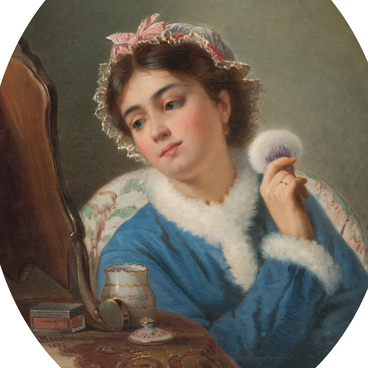The museum exposition displays an antique cabinet which is attributed to the ‘Boulle style’ furniture. This decorative style was named after a French master André-Charles Boulle. The cabinet is made in the marquetry technique: it is inlaid with patinated brass and tortoiseshell. The upper part of the cabinet — the countertop — is made of gray marble.
André-Charles Boulle was a famous furniture-maker of the 17th-18th centuries, an engraver, an ornamentalist painter and a master of wood carving. Rich marquetry became Boulle’s calling card. He used various types of materials for his creations: wood, tortoiseshell, ivory, mother-of-pearl, brass, silver, bronze and others. The marquetry technique consists in cutting two sheets of inlay out of two different, but sandwiched together sheets of veneers, and then combining them into a single pattern, thus achieving two differently colored panels.
The “Boulle” style involved the use of various exotic materials, making furniture out of different types of wood. The wood for finishing was cut into thin planks. The tortoiseshell was flattened under a press, then polished and sometimes tinted on the inside to bring some depth. All other materials were also first flattened under a press, and then cut into plates of the required size. The finished tortoiseshell plates were folded with a thin metal plate made of brass or tin alloy and placed between two sheets of wood. Then, they were glued together, a drawing of a pattern was done and a pattern was carved with a fretsaw through all the layers of wood, metal and tortoiseshell.
The diversity and luxuriousness of Boulle’s décor corresponded well to the public’s taste in the era of the French king Louis XIV, and the artist quickly gained fame. He was called “the most skilled cabinetmaker in Paris”, and in 1672 Louis XIV himself gave an order to allocate lodgings for Boulle in the galleries of the Louvre, and appointed him a court master.
Subsequently, many furniture-makers imitated this technique, and the style began to be called by the name of its creator — “Boulle”. It was considered especially fashionable in the era of Napoleon III. The overall style of this era can be characterized by the word “wealth”: masters offered a plethora of jewelry items, carefully chose various materials and created a variety of décor options. The most striking features of the “Boulle” style of the Napoleonic period were carefully worked out ornamented panels: they were heavy, always of high quality, and looked beautiful on large surfaces and furniture. Nowadays, the furniture of André-Charles Boulle can be seen in museums and private collections.
André-Charles Boulle was a famous furniture-maker of the 17th-18th centuries, an engraver, an ornamentalist painter and a master of wood carving. Rich marquetry became Boulle’s calling card. He used various types of materials for his creations: wood, tortoiseshell, ivory, mother-of-pearl, brass, silver, bronze and others. The marquetry technique consists in cutting two sheets of inlay out of two different, but sandwiched together sheets of veneers, and then combining them into a single pattern, thus achieving two differently colored panels.
The “Boulle” style involved the use of various exotic materials, making furniture out of different types of wood. The wood for finishing was cut into thin planks. The tortoiseshell was flattened under a press, then polished and sometimes tinted on the inside to bring some depth. All other materials were also first flattened under a press, and then cut into plates of the required size. The finished tortoiseshell plates were folded with a thin metal plate made of brass or tin alloy and placed between two sheets of wood. Then, they were glued together, a drawing of a pattern was done and a pattern was carved with a fretsaw through all the layers of wood, metal and tortoiseshell.
The diversity and luxuriousness of Boulle’s décor corresponded well to the public’s taste in the era of the French king Louis XIV, and the artist quickly gained fame. He was called “the most skilled cabinetmaker in Paris”, and in 1672 Louis XIV himself gave an order to allocate lodgings for Boulle in the galleries of the Louvre, and appointed him a court master.
Subsequently, many furniture-makers imitated this technique, and the style began to be called by the name of its creator — “Boulle”. It was considered especially fashionable in the era of Napoleon III. The overall style of this era can be characterized by the word “wealth”: masters offered a plethora of jewelry items, carefully chose various materials and created a variety of décor options. The most striking features of the “Boulle” style of the Napoleonic period were carefully worked out ornamented panels: they were heavy, always of high quality, and looked beautiful on large surfaces and furniture. Nowadays, the furniture of André-Charles Boulle can be seen in museums and private collections.



